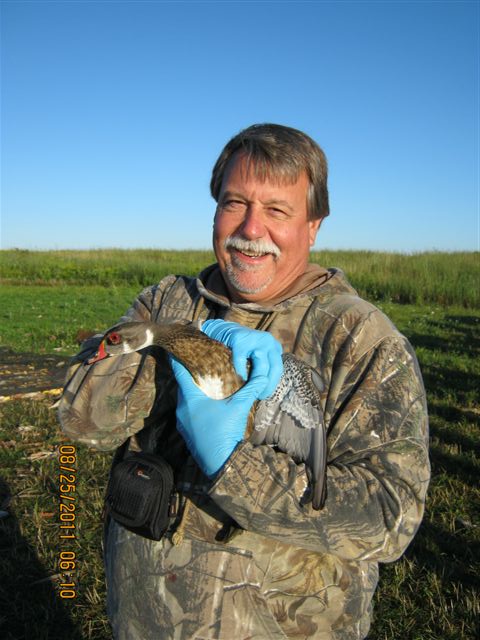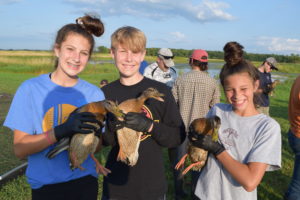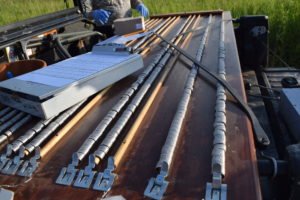 By Bruce Urben, WWA President
By Bruce Urben, WWA President
This article originally appeared in Wisconsin Waterfowl Association’s August Volunteer Newsletter edition.
Every year, in August, it is an Urben family tradition to help WDNR band ducks at a local waterfowl management area with all of the grandkids. They have been helping band since they were 5 or 6 years old, so it’s going on over 8 years now. They tell me they learn something new every year about duck behavior or duck anatomy. This year they saw the difference between a pure bred black duck and a black duck/mallard cross. The DNR Wildlife biologist was very good in explaining the traits of each for the interested audience. I have to tell you, when the grandkids started, there were many, many questions when the DNR biologists were determining the age and sex of the ducks. Now I think most of them can come up with the accurate age and sex almost 90% of the time (in fact I challenged them this year and they only had 1 or 2 wrong for age/sex).
 While we were waiting for the DNR to blow the net, I quizzed them on why we banded ducks… and they actually remembered. And, it seemed to make sense to them. Yes, Grandpa was proud!
While we were waiting for the DNR to blow the net, I quizzed them on why we banded ducks… and they actually remembered. And, it seemed to make sense to them. Yes, Grandpa was proud!
Well, why do we band ducks each year?
One of the primary reasons for banding is to identify wintering areas and migration routes used by ducks. We also can determine the survival rates and behavior of the birds through hunter band recovery studies. Data from the banded birds is used to monitor populations, set hunting bag limits and restore potentially threatened or endangered species. Banding has been going on internationally since 1946 and in Wisconsin since the late 1950’s.
Well, how does it work?
 The WDNR Wildlife biologists bait (usually with corn) an undisturbed waterfowl area and set up their capture nets that can shoot up and over the feeding ducks. The nets are powered by small cannons that are activated by a DNR biologist hidden from view. The net is shot and the chaos begins. Volunteers are called in to help secure the edges of the net and the volunteer teams begin to help carry the ducks to a team of WDNR biologists who estimate age (mature or immature) and sex of the bird. An aluminum band with a specific etched number is attached to the leg of the duck, numbers are recorded and the duck is released back to the marsh. The whole process seems to be well choreographed and directed.
The WDNR Wildlife biologists bait (usually with corn) an undisturbed waterfowl area and set up their capture nets that can shoot up and over the feeding ducks. The nets are powered by small cannons that are activated by a DNR biologist hidden from view. The net is shot and the chaos begins. Volunteers are called in to help secure the edges of the net and the volunteer teams begin to help carry the ducks to a team of WDNR biologists who estimate age (mature or immature) and sex of the bird. An aluminum band with a specific etched number is attached to the leg of the duck, numbers are recorded and the duck is released back to the marsh. The whole process seems to be well choreographed and directed.
The band numbers are recorded and the information is sent to the Federal Duck Banding lab in Maryland, where they are stored. State and Federal agencies utilize this data as well as the hunter band return results to make management decisions.
What can go wrong, you ask?
 Well, it is a tussle to keep other animals out of the bait, such as raccoons, cranes or geese who could be harmed by the netting or release process if captured. And, well, ducks are pretty smart (ask any waterfowler), and any little noise or movement can spook the whole bunch.
Well, it is a tussle to keep other animals out of the bait, such as raccoons, cranes or geese who could be harmed by the netting or release process if captured. And, well, ducks are pretty smart (ask any waterfowler), and any little noise or movement can spook the whole bunch.
This night we captured 190 ducks and banded 186 (yes, 4 got away before we could get them to banding). A huge success. In a matter of 60 minutes from the net fire we had the ducks banded, the site cleaned up and the net reset for another round the next day.
This isn’t possible without help from a team of volunteers. I would encourage you to come out and help if you have the time. Banding is being done by WDNR all over the state over the next few weeks. Contact your local WDNR in your area for opportunities or check out our website with banding information from the DNR. And, who knows, maybe you will start a new family tradition.












































